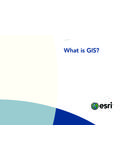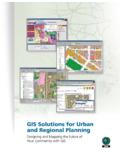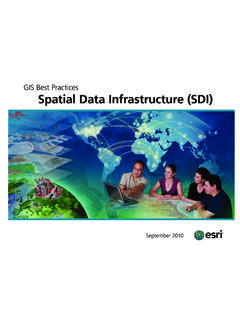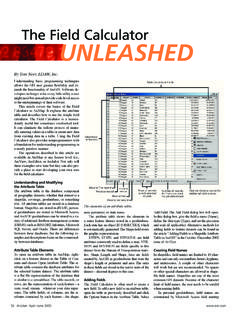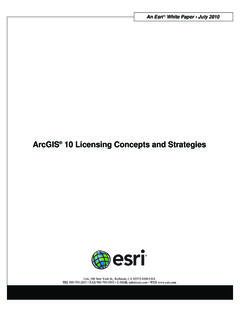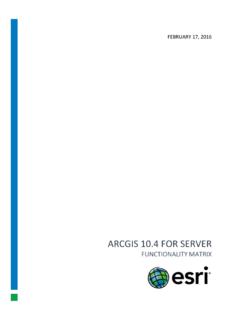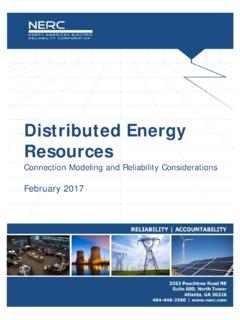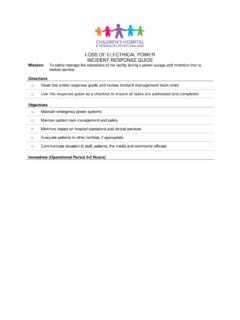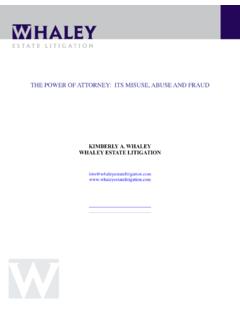Transcription of GIS Solutions for Power Generation and Transmission Services
1 GIS Solutions for Power Generation and Transmission Services Asset Management Engineering Environmental Studies Grid Analysis Land Management Logistics Market Assessment Regulatory Compliance Right-of-Way Management Site Selection Vegetation Management GIS Solutions for Power Generation and Transmission Services Balancing the need to develop new markets, improve system reliability, and reduce operation costs is the greatest challenge for today's utility decision makers a challenge that is successfully met with ESRI's geographic information system (GIS) software. GIS provides Solutions across the entire enterprise for applications in business, engineering, environmental management, and other disciplines neces- sary for comprehensive and effective Power Generation and Transmission management. An enterprise ArcGIS implementation for utility companies GIS is used for planning and monitoring Power Generation provides spatial query and geographic visualization to virtually resources.
2 Sophisticated spatial analysis is useful for deter- every employee. Interoperability built into ESRI's GIS software mining optimum Generation potential, formulating what-if enables the utility company's core business systems to work scenarios, studying environmental impact, and manag- in harmony with GIS, providing corporate-wide, integrated ing facility assets. GIS is used to spatially analyze network Solutions . This brochure offers real-world case studies that congestion, consider growth opportunities for renewable demonstrate how ESRI's GIS software is being used for gen- energy sources, determine site feasibility, and create energy eration and Transmission purposes. resource market scenarios. Using ESRI's GIS technologies, Generation and Transmission Power companies can intelligently plan, build, monitor, and companies improve their business operations by manage their Transmission networks using ESRI technology.
3 The ArcGIS geodatabase is a key component for maintain- Analyzing market potential ing and managing accurate Transmission asset data such Reducing maintenance costs as substations, lines, and associated structures. Use GIS to Optimizing assets assess grid reliability levels and formulate plans for improving Monitoring environmental impacts reliability, meet compliance requirements, site and manage Transmission corridors, inventory and schedule right-of-way Automating processes maintenance, and analyze load growth or changes in load Streamlining work procedures shape or strain on substation capacities. Improving earning potential Integrating business systems GIS Solutions for the Enterprise Eskom employees in South Africa log on to the company intranet and use GIS mapping tools to view extensive Transmission line data. This customized Map Viewer tool shows the location of a downed Transmission tower and a photo.
4 Employees can add other layers of information or access other maps relevant to their jobs. Power companies around the world are using new business strategies to better manage and improve service. GIS offers Generation and Transmission organizations a method of quickly accessing and producing maps, leveraging database information, and automating work processes. ESRI's GIS soft- ware is an open system conforming to information technology standards and therefore can be used throughout the enterprise for a variety of busi- ness processes. Integrating ArcGIS into corporate systems streamlines daily work ow and improves decision making and collaborative efforts for sound business management. ArcGIS Data Models for the Utility Industry Electric Distribution Electric Transmission Gas Distribution Energy Utilities MultiSpeak Land Parcels Pipeline Telecommunications Site Selection and Evaluation Generation site placement studies are supported using GIS.
5 For example, building a hydropower station requires thorough stud- ies of geological lithologies, water drainage patterns, surface, and subsurface structures. The geological, structural con guration is essential to understand the strengths and weaknesses of the area so the project can be implemented in suitable terrain. GIS is used to process this data to show, for example, the hydropower potential of an area. Using information, such as spot height topographic maps and digitized data about elevation contours, ArcGIS can generate digital elevation models (DEMs). GIS is used to layer additional data on the DEM such as catchment boundar- ies, drainage networks, and location of major habitation and environmental factors. Companhia Paranaense de Energia Brazilian forests and environmental efforts are of national concern and the focus of international scrutiny.
6 The Companhia Paranaense de Energia (Copel) implemented an environmental management system (EMA) to plan the environmental preserva- tion of the region it serves. EMA incorporates GIS applications that are used to manage the Power company's environmental GIS shows the effects of a planned reservoir. compliance. Copel supplies electricity to three million consumers with 6,800 km of Transmission lines. It owns 18 Power plants of which 17 are hydroelectric Power plants. Copel decision makers use EMA, which is built on ArcGIS 8, to consider a number of sustainable and environmental factors in determining facility placement and the ensuing consequences such as health bene t and threat, socioeconomic effects, and environmental impacts of constructing Generation facilities such as dams. EMA uses a geodatabase composed of alphanumeric and carto- graphic registration data to devise comprehensive environmental preservation plans.
7 The system allows Copel to support the legality of its real estate registrations. It is also used to provide relocation plans for families whose properties are affected by the construction of reservoirs. Orthophoto image and GIS layers depict environmental impact. Site Selection and Evaluation The system was put to the test when Copel constructed its Salto Caxias Power plant. The construction impacted 600 families in the 19,000 hectares of land to be ooded. Copel covered all relocation costs. The enormity of this project attracted interna- tional attention, and the company could not afford mistakes. All contingencies had to be considered; therefore, Copel divided the project's use of EMA into several subsystems including water management, contingency planning for oods and damages to North Sea Wind Parks Location Selection the dam, and relocation of expropriated people as a result of Nuon, one of the largest energy companies in the Netherlands, the construction of reservoirs.
8 Other related GIS applications is planning wind parks on the continental shelf of the Dutch were developed for handling environmental licenses, recovery of North Sea. A GIS application will assist the company in its quest degraded areas, zero ef uents and waste caused by the Power for suitable locations. A myriad of factors complicates the actual plant's maintenance process, and agrarian management includ- selection process, ranging from density of shipping traf c and ing production of seedlings. For example, one application takes the proximity of drilling rigs to bird migration patterns and mili- into consideration multiple factors to present spatial reports tary restrictions. Each factor has its own weight in the decision- such as the limits of the state's municipalities, the main rivers of making process. Superimposing the data that has been charted Paran , and data about Copel's Transmission lines.
9 On separate maps helps in the selection of suitable locations. On the new interactive and multilayered map, the weight of each factor can be adjusted and a sensitivity analysis can be executed for all concerned parties. Site Selection and Evaluation Wind turbine placement model considers wind patterns, environ- mental impact, elevation, Transmission lines, and so forth. Thanks to Linda Deker for this map. Salmon Arm Forest District Accurate wind turbine placement requires geographic and envi- Yampa Valley Electric Association ronmental analysis that includes multiple variables, which can Yampa Valley Electric Association (YVEA) serves approximately be computed and displayed with GIS. GEM Mapping and Design 12,000 customers in Steamboat Springs, Colorado, and the developed a wind tower site analysis model that was used to surrounding area from Xcel Energy's Steamboat Springs Substa- determine the most ideal locations for establishing wind turbines tion.
10 A 230-kilovolt electric Transmission line from the Wolcott in the Salmon Arm Forest District, British Columbia, Canada, pri- Tap supplies the Steamboat Springs Substation. YVEA also has marily in areas where there are fairly steady wind patterns with a 69-kilovolt Transmission line running to the Steamboat Springs the least impact on the environment and neighboring communi- Substation from the Mt. Harris Substation. The 69-kilovolt line ties. The determination of the best turbine locations was based can only provide a limited amount of backup Power . Without an on the following criteria: close to Transmission lines and existing additional high-voltage source of Power , the Steamboat Springs roads, in areas of moderate elevation, away from wetlands, and area is at risk during an outage of the existing 230-kilovolt line. away from mature tree stands.
